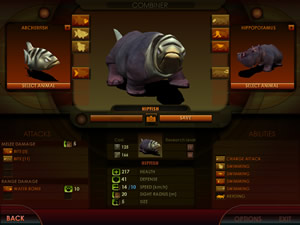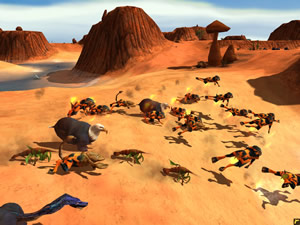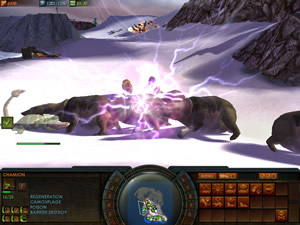Exit the dragon zebra,
enter the tiger hippo.
Be it chess, Pokemon or WarCraft,
there is no element more essential to a strategy game’s success than unit balance.
It’s a classic struggle for designers, who must constantly weigh the pros and
cons of every single playable unit against every other unit in the game. Cost
versus strength, efficiency versus prevalence – it can be a real nightmare trying
to figure out exactly how many gold pieces one zombie is worth when dealing with
30 other types of creatures.
Now,
imagine if you were dealing with, let’s say, ONE MILLION other unit types. Where
would you start? How would you even begin to balance these things into a fun,
playable strategy game?
I have no idea, which is partly why I wasn’t asked
to join the team behind Relic’s new Impossible Creatures (I also have no
developer credentials or programming experience, which may have also been a factor).
Powered by a revolutionary unit design tool, this real-time strategy game is indeed
a horse-monkey of a different color.
Set in the late 1930’s, Impossible
Creatures tells the story of Rex Chance, fearless adventurer and son of kooky
scientist Dr. Erik Chanikov. Rex receives an alarming letter from his father that
calls him to the Isla Varietas chain in the South Pacific. Soon after arriving,
Rex finds himself embroiled in a strange tale of power-hungry evildoers, stupid
henchmen and more genetic oddities than you’d find at a Gwar
concert.
While at first glance this seems like a straightforward real-time
strategy affair, it’s anything but. Using the ‘Sigma’ technology pioneered by
his father, Rex (er, you) has at his command over 50 representatives from the
Animal Kingdom… but not the cute, fuzzy kingdom we see on the Discovery Channel.
Rather, you build your armies by combining the genes of two animals, creating
a decidedly uncute, unfuzzy, and unforgiving evolutionary aberration with which
you’ll fight all kinds of other freaks of nature.
The main game mode is its
Campaign, which takes you through 15 different missions on 14 different islands.
Rex’s odd and occasionally funny story unfolds through black and white montages
and in-game cinematics, both of which are nicely done and set the creepy tone
well. Suffice to say that Rex has to deal with worse things than just mean scientists.
Like a ratwhale, for example. Or maybe a rhinocamel.
Fighting fire with fire
seemed to work just fine for cavemen, so in order to deal with the monstrosities
that your enemies send against you, you have to build an army. As you progress
through the game, you can take DNA samples of the various wildlife you encounter
(there are a few on each level), which are then permanently added to your private
collection. But a gorilla is no good as just a gorilla, right? I mean, he can’t
even fly!
 Unless
Unless
you cross breed him with a hornet, that is. The Army Building mode is the meat
and potatoes of Impossible Creatures, and it’s quite an impressive system.
You simply take two animals and swap body parts until you create that freak
de resistance you’re aiming for. The 50+ animals have different abilities,
which in turn cost different amounts of coal and electricity, the only two resources
found in the game. Considering that many have 5 or 6 body parts to swap, you’re
looking at somewhere around four gazillion possible creatures. In essence, the
folks at Relic have simply put the task of unit design and balance into your hands,
opposable thumbs and all.
Splicing animals into monsters is every weird kid’s
dream! There are all sorts of stats to track as you design – attack, defense,
speed, size, resource costs, etc. You want a poisonous frog with the size and
health of a musk ox? Then go for it, but remember that the poison costs extra.
It’s just a blast playing God and trying to create an uber-efficient monstrosity.
My best creation seems to be a Crocomeleon, which is a crocodile’s body with
the head and tail of a chameleon. It can camouflage, regenerate and spit out a
nasty ranged tongue attack while maintaining good defense and health. Plus, it
looks kinda like a dragon, which satisfies my closet geek. Wait, I’ve
opened that door already, haven’t I. Crap.
Though the Campaign requires
you to tag an animal before it’s available, the single-player Skirmish mode does
not, so you can always jump in with the full payload and go nuts just for fun.
And as it turns out, that’s probably a better idea than actually playing
the game.
The gameplay in Impossible Creatures isn’t bad so much as
very, very straightforward. It plays like any run-of-the-mill RTS, with tons of
clicking and building and hiring grunts and setting up defenses and whatnot. Most
of the strategy is found in the actual unit designing rather than the actual game
playing.
But the typical problems of the genre were not weeded out; namely,
poor unit AI and questionable pathfinding. The game presents itself as an action-based
RTS, which is very true since you spend most of your time babysitting your units.
You can set basic attack rules (territorial, only attack when attacked, etc.),
but they don’t work very well, an fact proven by units that go scampering off
into the great misty unknown chasing an enemy henchman. Trying to get a clump
of units through a narrow pass it like dropping a bucket of clams in a coin slot.
Rather than wait their turn to get through, some units will try to get around
the pass by going literally around the world, probably in about 80 days. Must
be all the inbreeding.
 Units
Units
also have a hard time prioritizing things. In the middle of an enemy base, you
might find your beasties wailing on an anti-air tower while a Great White Scorpion
nibbles on their toes. They don’t recognize immediate threats and never run away
unless you tell them to, which means you’ll spend most of your time on top of
every battle like a proud, irritated father.
At least it looks cool, thanks
to a pretty solid 3D engine. Considering the insane variety of units, Impossible
Creatures handles the rendering admirably. Though it won’t look great on anything
less than a relatively high end machine, the colorful creature and terrain textures
coupled with a fully realized 3D landscape make for a good-looking experiment.
Framerate problems occur when dealing with tons of units, but that’s to be expected
in a fully 3D game.
You can zoom and rotate quickly, but a few of the controls
are locked – specifically, the rotate ability, which is fixed as the ALT key.
That also happens to be right next to the dreaded ‘Windows’ key on the standard
keyboard. I wanted to switch it to the middle mouse button, but no-can-do.
The sounds are fine, particularly the swingin’ music. However, the constant ‘creatures
are under attack!’ warning will drive you insane. You have been warned.
Should
you tire of playing the computer, you take your beasties online and challenge
other mad scientists. The games tend to be pretty quick, averaging about a half-hour,
but also tend to follow the same formula of just mobbing each other’s base as
soon as possible. Again, the strategy is mainly found in the unit designing.
And
that can be considered both its windfall and its downfall. Though it struggles
a bit as a real-time strategy game, Impossible Creatures makes great strides
in unit building and should be commended for its lofty goals. More emphasis on
actual gameplay refinement would have led to a better game, but I suppose evolution
moves one step at a time.

-
Awesome creature combining
-
Good engine
-
Great concept
-
Very standard gameplay
-
Significant AI issues











